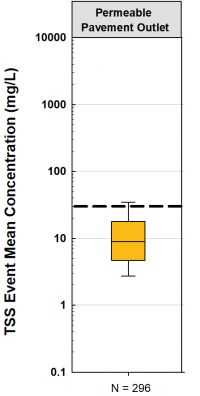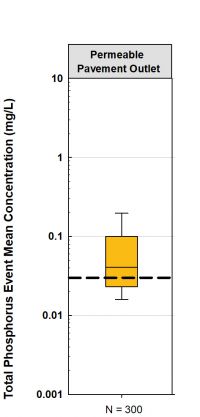Difference between revisions of "Permeable pavements: Performance"
| Line 36: | Line 36: | ||
==Recent Performance Research== | ==Recent Performance Research== | ||
[[File: | [[File:BMP mapping tool.PNG|thumb|400px|One of STEP's sites located in Mississauga, ON. (Lakeview Neighbourhood), where P.P was installed in residential driveways. Full submission and details to the BMP can be selected on the map viewer and can be viewed [https://igeowater.com/InternationalBMPDBAssets/PDF/Description/00608--DESCP.pdf here.] (International Stormwater BM<P Database, 2021<ref>International Stormwater BMP Database. 2021. BMP Mapping Tool. Retrieved Feb. 28, 2023. https://bmpdatabase.org/bmp-mapping-tool</ref>)]]. | ||
*[https://www.conteches.com/Portals/0/Documents/Product%20Evaluation%20and%20%20Testing/vx_harding_township.pdf?ver=2018-05-31-143332-863 (Clary et al., 2020) - International Stormwater BMP Database: 2020 Summary Statistics.] | *[https://www.conteches.com/Portals/0/Documents/Product%20Evaluation%20and%20%20Testing/vx_harding_township.pdf?ver=2018-05-31-143332-863 (Clary et al., 2020) - International Stormwater BMP Database: 2020 Summary Statistics.] | ||
**The International Stormwater Best Management Practices (BMP) Database is a publicly accessible repository for BMP performance monitoring study, design, and cost information. As of December 2019, the BMP Database contains data sets collected over four decades from over 700 BMP studies through the U.S., Canada, Sweden, New Zealand, Australia, China, etc. that are accessible on the project website ([www.bmpdatabase.org]). The performance data for both TSS and TP are as follows within the report: | **The International Stormwater Best Management Practices (BMP) Database is a publicly accessible repository for BMP performance monitoring study, design, and cost information. As of December 2019, the BMP Database contains data sets collected over four decades from over 700 BMP studies through the U.S., Canada, Sweden, New Zealand, Australia, China, etc. that are accessible on the project website ([www.bmpdatabase.org]). The performance data for both TSS and TP are as follows within the report: | ||
***Median TSS value of outflow/effluent of stormwater from P.P is 22 mg/L in comparison to 77 mg/L influent levels. These levels are computed using the BCa bootstrap method described by Efron and Tibishirani (1993). This value is below the required | ***Median TSS value of outflow/effluent of stormwater from P.P is 22 mg/L in comparison to 77 mg/L influent levels. These levels are computed using the BCa bootstrap method described by Efron and Tibishirani (1993). This value is below the required CWQG levels for TSS in stormwater. | ||
***Median Total phosphorus (TP) value of outflow/effluent of stormwater from P.P is 0.10 mg/L in comparison to 0.17 mg/L influent levels. These levels are computed using the BCa bootstrap method described by Efron and Tibishirani (1993). This value is below the required | ***Median Total phosphorus (TP) value of outflow/effluent of stormwater from P.P is 0.10 mg/L in comparison to 0.17 mg/L influent levels. These levels are computed using the BCa bootstrap method described by Efron and Tibishirani (1993). This value is below the required federal (Environment Canada, 2004) and provincial (OMOEE, 1994) levels for TP in stormwater ((Clary et al., 2020<ref>Clary, J., Jones, J., Leisenring, M., Hobson, P. and Strecker, E. 2020. International stormwater BMP database 2020 summary statistics. Water Environment & Reuse Foundation.</ref>). | ||
<ref>Clary, J., Jones, J., Leisenring, M., Hobson, P. and Strecker, E. 2020. International stormwater BMP database 2020 summary statistics. Water Environment & Reuse Foundation.</ref>). | |||
*[https://www.eeer.org/upload/eer-14-4-262-.pdf (Jianghua, et al. 2009) - Performance Analysis of a Hydrodynamic Separator for Treating Particulate Pollutants in Highway Rainfall Runoff.] | *[https://www.eeer.org/upload/eer-14-4-262-.pdf (Jianghua, et al. 2009) - Performance Analysis of a Hydrodynamic Separator for Treating Particulate Pollutants in Highway Rainfall Runoff.] | ||
Revision as of 21:07, 28 February 2023
TSS Reduction[edit]
The performance results for Permeable pavement/Porous Asphalt: Life Cycle Costs practices, located within TRCA's watershed originate from three primary sites:
- Kortright Centre Parking Lot
- Seneca College
- IMAX Corporation, head office
The mean performance value recorded at the outlet for Permeable Pavement practices' ability to remove Total Suspended Sediments (TSS) was was calculated based on 296 separate recordings between 2005-2007, and 2010-2017 amongst the three sites previously mentioned.
As can be seen in the corresponding boxplot the mean performance removal efficiency of the permeable pavement practices monitored are well below the suggested guideline of 30 mg/L (Canadian Water Quality Guideline (CWQG), or (background (assumed at <5 mg/L)+ 25 mg/L for short term (<24 hour) exposure) (CCME, 2002[1]; (TRCA, 2021[2]).
The median value of the 301 samples taken was 8.95 mg/L whereas the mean was 17.10 mg/L, with a 12% guideline exceedance.
Phosphorus Reduction[edit]
The performance results for Permeable pavement/Porous Asphalt: Life Cycle Costs practices, located within TRCA's watershed originate from three primary sites:
- Kortright Centre Parking Lot
- Seneca College
- IMAX Corporation, head office
The mean performance value recorded at the outlet for Permeable Pavement practices' ability to remove Total Phosphorus (TP) was calculated based on 300 separate recordings between 2005-2007, and 2010-2017 amongst the three sites previously mentioned.
As can be seen in the corresponding boxplot, the mean performance removal efficiency of the bioretention practices monitored are not meeting the acceptable upper extent range of nutrients as of 0.03 mg/L (30 µg/L) (Environment Canada, 2004[3]; OMOEE, 1994[4]).
The median value of the 355 samples taken was 0.04 mg/L whereas the mean was 0.08 mg/L, with a 62% guideline exceedance. Given the age of most of these practices, more inspection, maintenance and necessary rehabilitation will be needed to ensure they are able to meet the federal and provincial governments' guideline requirement for stormwater quality.
Please refer to the Phosphorus page and the additives page for more information on how LIDs can reduce contaminant loading in stormwater
Recent Performance Research[edit]
.
- (Clary et al., 2020) - International Stormwater BMP Database: 2020 Summary Statistics.
- The International Stormwater Best Management Practices (BMP) Database is a publicly accessible repository for BMP performance monitoring study, design, and cost information. As of December 2019, the BMP Database contains data sets collected over four decades from over 700 BMP studies through the U.S., Canada, Sweden, New Zealand, Australia, China, etc. that are accessible on the project website ([www.bmpdatabase.org]). The performance data for both TSS and TP are as follows within the report:
- Median TSS value of outflow/effluent of stormwater from P.P is 22 mg/L in comparison to 77 mg/L influent levels. These levels are computed using the BCa bootstrap method described by Efron and Tibishirani (1993). This value is below the required CWQG levels for TSS in stormwater.
- Median Total phosphorus (TP) value of outflow/effluent of stormwater from P.P is 0.10 mg/L in comparison to 0.17 mg/L influent levels. These levels are computed using the BCa bootstrap method described by Efron and Tibishirani (1993). This value is below the required federal (Environment Canada, 2004) and provincial (OMOEE, 1994) levels for TP in stormwater ((Clary et al., 2020[6]).
- The International Stormwater Best Management Practices (BMP) Database is a publicly accessible repository for BMP performance monitoring study, design, and cost information. As of December 2019, the BMP Database contains data sets collected over four decades from over 700 BMP studies through the U.S., Canada, Sweden, New Zealand, Australia, China, etc. that are accessible on the project website ([www.bmpdatabase.org]). The performance data for both TSS and TP are as follows within the report:
- (Jianghua, et al. 2009) - Performance Analysis of a Hydrodynamic Separator for Treating Particulate Pollutants in Highway Rainfall Runoff.
- This study examined the separation characteristics of particles in runoff from paved roads using a OGS hydro cyclone design. The results indicated the TSS concentration ratio between the overflow and inflow (TSSover/in) decreased as a function of the operational pressure and the particle removal efficiency was mainly affected by the particle size. By using highway runoff results showed that removal efficiency was greater than 60%. The TSSover/in was (0.26 mg/L – 0.41 mg/L) below the Canadian Water Quality Guidelines (CWQGs) (Jianghua, et al. 2009[7]).
- (Lee, et al. 2014) - Performance evaluation and a sizing method for hydrodynamic separators treating urban stormwater runoff.
- This study conducted performance monitoring over a 6-year period (137 separate storm events) of four different hydrodynamic separators in Korean urban catchments between 2006 - 2012. Removal rates were relatively low at all four sites (1. Roadway site: Avg. Inflow = 239.32 mg/L vs Avg. Outflow = 122.2- mg/L / 2. Residential site: Avg. Inflow = 59.74 mg/L vs Avg. Outflow = 50.35 mg/L / 3. Roadway Site: Avg. Inflow = 62.50 mg/L vs. Avg. Outflow = 33.76 mg/L / 4. Residential(63.5%) & Roadway (36.5%) CDA site: Avg. Inflow = 236.24 mg/L vs. Avg. Outflow = 160.54 mg/L). The low removal rates were due to high rates of extreme overflow events occurring with most suspended sediment being quite small/fine in nature (<75μm)(Lee, et al. 2014[8].
References[edit]
- ↑ Canadian Council of Ministers of the Environment (CCME). 2002. Canadian water quality guidelines for the protection of aquatic life: Total particulate matter. In: Canadian Environmental Quality Guidelines, Canadian Council of Ministers of the Environment, Winnipeg
- ↑ TRCA. 2021. Spatial Patterns (2016-2020) and Temporal Trends (1966-2020) in Stream Water Quality across TRCA’s Jurisdiction Prepared by Watershed Planning and Ecosystem Science. https://trcaca.s3.ca-central-1.amazonaws.com/app/uploads/2021/10/29113334/2016-2020-SWQ-Report-v11_FINAL_AODA-FA.pdf
- ↑ Environment Canada. (2004). Canadian guidance framework for the management of phosphorus in freshwater systems. Ecosystem Health: Science‐based solutions report no. 1–8. Cat. No. En1–34/8–2004E.
- ↑ Ontario Ministry of Environment and Energy (OMOEE), 1994. Policies, Guidelines and Provincial Water Quality Objectives of the Ministry of Environment and Energy. Queen’s Printer for Ontario. Toronto, ON.
- ↑ International Stormwater BMP Database. 2021. BMP Mapping Tool. Retrieved Feb. 28, 2023. https://bmpdatabase.org/bmp-mapping-tool
- ↑ Clary, J., Jones, J., Leisenring, M., Hobson, P. and Strecker, E. 2020. International stormwater BMP database 2020 summary statistics. Water Environment & Reuse Foundation.
- ↑ Jianghua, Y., Qitao, Y. and Kim, Y. 2009. Performance analysis of a hydrodynamic separator for treating particulate pollutants in highway rainfall runoff. Environmental Engineering Research, 14(4), pp.262-269. https://www.eeer.org/upload/eer-14-4-262-.pdf
- ↑ Lee, D.H., Min, K.S. and Kang, J.H., 2014. Performance evaluation and a sizing method for hydrodynamic separators treating urban stormwater runoff. Water science and technology, 69(10), pp.2122-2131)


